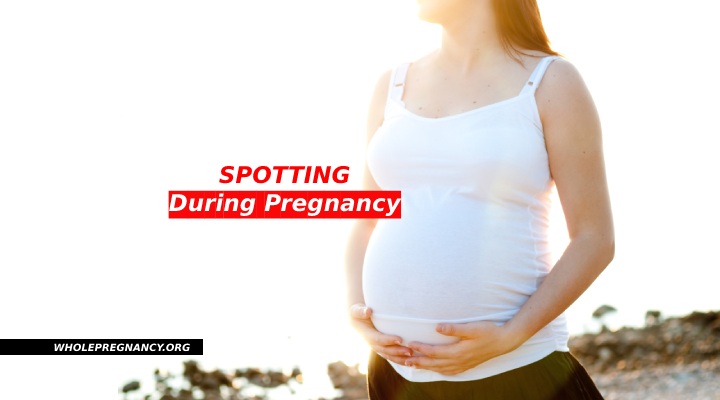Bleeding and spotting during pregnancy is something common among pregnant women. One in four (or 25%) pregnant women experience some bleeding or spotting.
While bleeding and spotting during pregnancy are not always a sign that there is a problem they could be an indicator of miscarriage, or other serious complications. A miscarriage occurs when a baby is born prematurely or in a weakened state.
If you experience bleeding or spotting, call your doctor . Although it may not be serious, your health care provider should investigate the cause.
What is The Difference Between Bleeding or Spotting?
Bleeding and spotting can occur at any time, starting when you become pregnant until the moment you give way. Spotting refers to light bleeding. Spotting occurs when there are a few drops on your underwear. The blood won’t cover a pantsy liner if the spotting is so slight. Bleeding occurs when blood flows are heavier and you will need to use a pad or panty liner to prevent the blood from getting under your clothes.
What To Do if You Are Bleeding and Spotting During Pregnancy?
If you experience bleeding problems during pregnancy, please call your doctor.
- You should keep track of how heavy your bleeding gets, how it changes, and how many pads are you using.
- It is important to check the color of the blood. This information may be requested by your provider. You can choose from a variety of colors like dark, bright, or brown.
- When you are bleeding, don’t use a tampon, don’t take showers and don’t even have sex.
If you are pregnant, call your doctor immediately after you are:
- Heavily bleeding
- Bleeding from pain or cramping
- Bleeding and dizziness
- Pelvic pain or discomfort in the abdomen or pelvis
What Causes Bleeding & Spotting Early in Pregnancy?
In early stages of pregnancy, it’s common to experience some bleeding or spotting. It is possible to have spotting or bleeding in the first trimester. You can cause it by:
- Having sex can cause bleeding and sporrting during the first trimester of pregnancy.
- Infections.
- Implantation. The moment a fertilized egg (embryo), attaches to the lining (womb) of the uterus and begins to grow.
- Hormone changes. Hormones can be described as chemicals that are made by the body.
- Your cervix may change. The cervix opens to the uterus, which is located at the top of your vagina.
- There are certain types of pregnancy testing, such as an amniocentesis (CVS) or Chorionic villus sampling (AMN). These tests are used to determine if there are any genetic abnormalities in your baby. Genetic abnormalities refer to genetic changes that have been passed on from mother or father to their baby. These genetic changes can lead to health problems in a baby’s body.
- Smoking can cause problems. It’s best to quit smoking before you become pregnant.
Sometimes bleeding or spotting during the first trimester can be a sign that there is a serious problem such as:
- Miscarriage. Most women who miscarry experience bleeding or spotting prior to the miscarriage.
- Ectopic pregnancies. When a fertilized egg implantes itself outside the uterus and starts to grow. Ectopic pregnancy does not end with baby birth. In fact, it can lead to serious and dangerous complications for the mother.
- A Molar pregnancy. When a mass of tissue develops in the womb instead of a baby. Molar pregnancy is uncommon.
What Causes Bleeding and Spotting in Later pregnancy?
The following factors could cause bleeding or spotting in later stages of pregnancy:
- Labor
- Penetration during sexual activities
- In some cases an internal exam
- Problems with your cervix such as an infection, growths or inflammation, or cervical deficiency. When a woman’s cervical opening is too early. This is when the cervix becomes inflamed.
Bleeding or spotting may occur later in pregnancy and could indicate a serious problem such as:
- Preterm labour. It is labor that occurs too soon, before 37 weeks.
- Uterine rupture. When the uterus bursts during labor. This is very rare. This can occur if there is a scar on your uterus from an earlier cesarean birth (also known as c-section or another type of surgery on your uterus). C-section refers to surgery where your baby is delivered through a cut made by your doctor in your abdomen and uterus.
- Placental abruption. It is when the placenta splits from the wall in the uterus.
- Placenta previa. This is when the placenta covers most or all of the cervix and lies very low within the uterus.
- Placenta inaccreta. When the placenta gets too deep into the wall of your uterus.
How Can You Treat Bleeding and Spotting?
The cause of your bleeding will determine the treatment you need. A medical exam and other tests may be required. The best treatment for bleeding or spots is usually rest. You may also be offered the following treatments by your provider:
- For a while, take some time off work to relax and get off your feet
- Your baby may require medicine to protect him from Rh disease. Rh disease occurs when your blood and that of your baby are not compatible (can’t be combined). This can lead to serious health problems, even death, for your baby.
- Do not sex, use tampons or have sex with others
- You may need surgery or hospitalization if you have severe bleeding.
